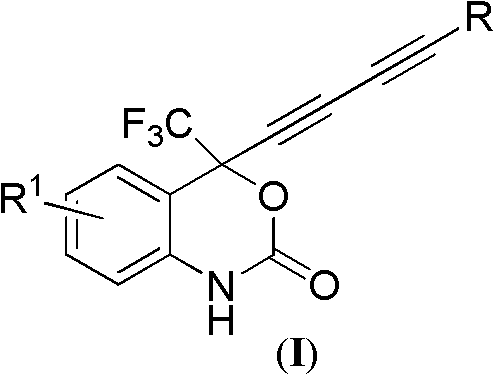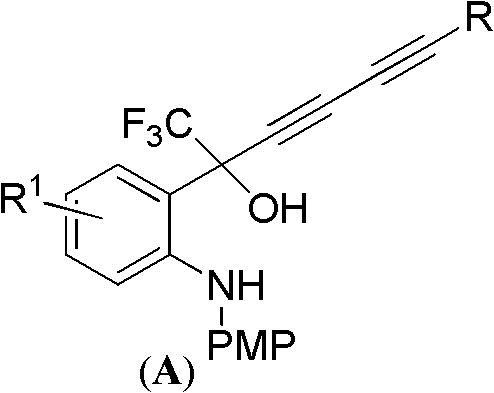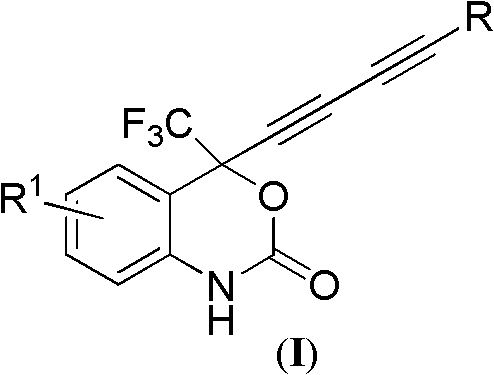4-(substituted-1,3-dialkynyl)-4-(trifluoromethyl)benzo-1,4-dihydroxazole-2-one compounds and preparation method and applications thereof
A technology of ketone compound and trifluoromethyl, which is applied in the field of benzo-1, achieves the effects of high yield, simple and feasible synthesis method, and good application value
- Summary
- Abstract
- Description
- Claims
- Application Information
AI Technical Summary
Problems solved by technology
Method used
Image
Examples
example 1
[0028] Example 1: When R is a cyclopropyl group, R 1 When it is 5-chloro, the synthesis of intermediate A:
[0029]
[0030] In a dry and argon-substituted 100 mL Schlenck reaction flask, add (1R,2S)-1-phenyl-2-(1-pyrrole) n-propan-1-ol (4.52 g, 22 mmol) and triphenylmethane (0.1 g), dissolved in anhydrous THF (10 mL). The mixture was cooled to -10°C, and 18.4mL (44mmol) of n-butyllithium in n-hexane (2.4M in hexanes) was slowly added to ensure that the temperature was below 5°C, and the addition was completed in 2 hours to obtain a wine-red solution. 4-Cyclopropyl-1,3-butadiyne (1.98 g, 22 mmol) was added and the addition was completed in 30 minutes. Stirring was continued at 0-5°C for 30 minutes, then cooled to -60°C. Add 5-chloro-2-(4'-methoxybenzylamino)phenyltrifluoromethylketone (3.44g, 10mmol) in tetrahydrofuran (5mL) dropwise into the wine red mixture to ensure the internal temperature of the reaction Below -50~-55°C. The reaction was continued to stir at this ...
example 2
[0031] Example 2: (S)-6-Chloro-4-(4-cyclopropanylbut-1,3-diynyl)-4-(trifluoromethyl)benzo-1,4-dihydrooxazine- 2-keto (S-1)
[0032]
[0033] 4.01 grams (9.2 mmol) of the compound obtained in Experiment 1 and triethylamine (2.32 g, 23 mmol) were dissolved in 12 mL of toluene, and then 20% phosgene toluene solution (11 g, 11.0 mmol) was added at room temperature for 30 minutes After the addition was complete, stirring was continued at this temperature for 1 hour. Methanol (0.12 g, 3.6 mmol) was added to react with unreacted phosgene for 30 minutes, 10 mL of water and 10 mL of ethyl acetate were added, the reaction mixture was transferred to a separatory funnel, and the organic layer was obtained by liquid separation. After drying, the solvent was removed under reduced pressure, separated by column chromatography, and a colorless viscous compound was obtained quantitatively.
[0034]The obtained viscous compound was dissolved in 20 mL of acetonitrile, 20 mL of an aqueous sol...
example 3
[0035] Example 3: (R)-6-chloro-4-(4-cyclopropanylbut-1,3-diynyl)-4-(trifluoromethyl)benzo-1,4-dihydrooxazine- 2-keto (R-1)
[0036]
[0037] A method similar to Example 1 and 2 uses 0.05 equivalents of (1S, 2S)-2-benzylmethylamino-1-(4-nitrophenyl)-3-(trityloxy) n-propan-1-alcohol As a chiral ligand, (R)-6-chloro-4-(4-cyclopropanylbut-1,3-diynyl)-4-(trifluoromethyl)benzo-1,4- Dihydrooxazin-2-one (R-1), yield 53%, 85% ee.
PUM
 Login to View More
Login to View More Abstract
Description
Claims
Application Information
 Login to View More
Login to View More - R&D
- Intellectual Property
- Life Sciences
- Materials
- Tech Scout
- Unparalleled Data Quality
- Higher Quality Content
- 60% Fewer Hallucinations
Browse by: Latest US Patents, China's latest patents, Technical Efficacy Thesaurus, Application Domain, Technology Topic, Popular Technical Reports.
© 2025 PatSnap. All rights reserved.Legal|Privacy policy|Modern Slavery Act Transparency Statement|Sitemap|About US| Contact US: help@patsnap.com



